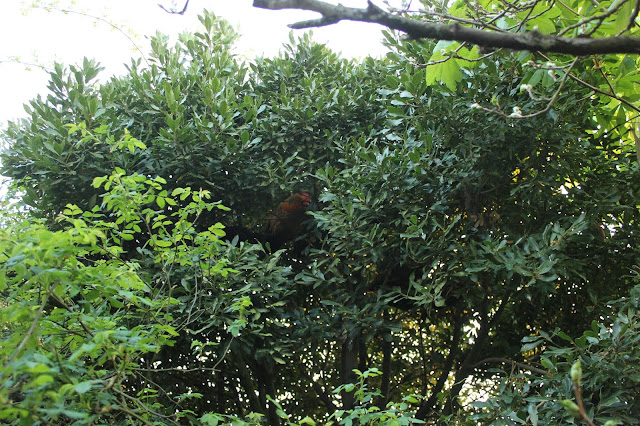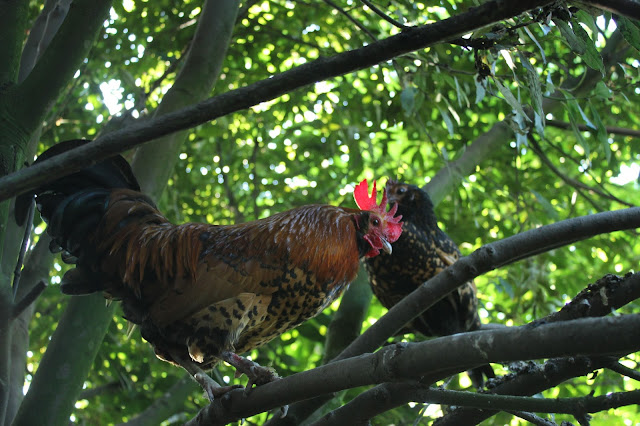It is the Holy Grail of many a chicken keeper not only to get their hens to put themselves to bed, which is easy-peasy but also to get the latter (or something) to close the hen house door. To this end they invest in all kinds of ladder systems and electronic door hatches and gadgets, when maybe all they really needed to do was to plant a tree.
My mother planted this bay tree over twenty years ago now, it was a single tiny sapling about ten centimetres high and it has flavoured many a fine casserole and delicious soup since. What perhaps we didn't expect was that it was also destined to become the nightly roost for over twenty of our chickens.
My mother planted this bay tree over twenty years ago now, it was a single tiny sapling about ten centimetres high and it has flavoured many a fine casserole and delicious soup since. What perhaps we didn't expect was that it was also destined to become the nightly roost for over twenty of our chickens.
I had wondered from the outset how far the making a forest garden for both ourselves and our poultry would entail a return to the latter's natural forest floor and tree-dwelling instincts. Now, having observed them in this nightly event of going to roost, I have been amazed by how complicated a ritual it is, involving seemingly individual hierarchical and group behaviours.
The choice of tree is also interesting, maybe I am reading too much into it but I am always amazed at how organised hens are and how much their practical and sybaritic needs are met in everything they do. The bay tree from a geographical point of view is protected, it is well situated against the North wall of the back of the longhouse and sheltered from the prevailing Westerlies from the sea by hedges and fencing. It is also at the heart of a mini shelter belt of acacia, horse chestnut, mulberry, climbing roses, buddleia and willow.
Being up against the house is not its only advantage, as it is right next to the door of an outbuilding, where some of the flock roost. Therefore, in the case of a sudden terrible downpour, the birds can change their minds and get indoors for the night. I also believe that psychologically, this tree, by its position has become an adjunct to the house, which makes it even safer in the minds of the hens. There is of course the fact that laurus nobilis is an evergreen, which makes it good, sheltered roosting at all seasons. It is also well covered with a thick crop of large, ovate, fleshy leaves and apart from cold weather damage loses very few of them. Thus it makes an excellent shelter from rain, hail and snow and also hides the birds from prying eyes from both above and below. At a height of over six metres it provides not only a means to get a very lofty perch but also a good view of the whole garden.
Being up against the house is not its only advantage, as it is right next to the door of an outbuilding, where some of the flock roost. Therefore, in the case of a sudden terrible downpour, the birds can change their minds and get indoors for the night. I also believe that psychologically, this tree, by its position has become an adjunct to the house, which makes it even safer in the minds of the hens. There is of course the fact that laurus nobilis is an evergreen, which makes it good, sheltered roosting at all seasons. It is also well covered with a thick crop of large, ovate, fleshy leaves and apart from cold weather damage loses very few of them. Thus it makes an excellent shelter from rain, hail and snow and also hides the birds from prying eyes from both above and below. At a height of over six metres it provides not only a means to get a very lofty perch but also a good view of the whole garden.
In fact it was during the recent cat trouble we experienced that those twenty plus pairs of eyes were the first to inform me of both the when and where from of the attacks. The branches of the bay are smooth and wide but also give to the wind thus maybe not only rocking the birds to sleep but also avoiding bough breakage. Another aspect of the tree is its smell, which comes not only from the aromatic leaves but also from the delicate sweet perfume of its flowers. So not only a harmonious environment in which to relax and sleep but also this makes for great sensory camouflage as I have always assumed predators can sniff birds out in their roosting places.
My observations of tree roosting are as follows and the process is even more complicated than the ritual that surrounds the perches in the hen house.
I have always been so careful to make sure that all the roosts in the hen houses were at the same height as this is crucial to avoiding power struggles. Height of roosting, as in height of crowing for cockerels is a really important factor in establishing dominance and/or can be used by inference to intimidate others. Here in the tree, the birds are beyond my interference and it is true there is a bit of squabbling that can go on in the evening with squawks of indignation. It seems places are reserved
.
The evening starts with one of my larger, though not necessarily dominant (things are very fluid here) cockerels scoping out the tree with a dominant hen. They go right to the top and the dominant hen sometimes stays there. The cockerel will then crow, and as you are probably aware crowing is used to signal the 'all clear' and I am guessing this is so here and as you will witness in the film below. The cockerel 'Mr Snuggles' then returns to earth and awaits the arrival of the rest of the tree dwellers. The hens and whatever cockerels decide to stay outdoors, (these latter are not always the same, as some of them prefer to rule over the roost in the outbuilding), now start to come to roost.
They sit initially on the lower branches, where they start a sort of collective preening operation, much like the ritual of washing and teeth cleaning. There is also a general chattering and communication going on at the same time. Then as the evening progresses, they start to move up the tree to their final roosting places. Often these are, as I wrote above, designated places but they do change. For example, I have noticed in the past few days Mr Snuggles for whatever reasons romantic or otherwise, has begun to sit lower down the tree with a mother hen and her chick rather than roost at the top of the bay with his usual coterie of females.
Mr Snuggles actual job as the evening wears on, seems to be as a sweeper of sorts, as he encourages the hens to move further up the tree. He will also return to earth at any time, if he feels someone is dawdling about in the garden and he will then 'chase' them up the tree. This is much the same behaviour I have seen in dominant and even lower order cockerels in hen houses. They will patrol the garden looking for any 'stop-outs'.
The cockerels however, will have none of this, if they decide to stay out to roost they pick their own place and at their own time. Many of the hens are also unwilling to obey commands from the officious Snuggles. However, my opinion is that this behaviour is ritualistic and I somehow feel the hens, the older ones definitely, move up the tree both because they know it makes sense but also because they know it is part of the 'game'.
As the tree is right outside our bedroom and as we really don't want to annoy the neighbourhood, we do remove the two usual tree-dwelling cockerels (sometimes three) from the tree each night. To do this Andy perfected the 'pallet wood chicken elevator', a simple T piece of wood, with which either to remove the rooster at ground level from below or at tree level from above.
Here demonstrated by Bungle, our golden, black-laced Polish hen.
Here demonstrated by Bungle, our golden, black-laced Polish hen.
If it was just us, living in the middle of nowhere, as I hope it will be any day soon, I would not bother as it would help me immeasurably to get everything done in the day, if I was up with the lark aka Mr Snuggles.
Now, if you'd like to, sit back and watch the film:
However, some of our chicks still prefer snuggling up to Mummy in a nice warm nest.
Thanks for dropping by and if you
have enjoyed this piece and found it useful think about sharing it and
also maybe about joining this blog. Please also feel free to ask
questions or make comments in the section below.
All the very best,
Sue
RETURN TO CONTENTS PAGE
© Sue Cross 2015













Hi Sue,
ReplyDeleteThis is one of my favourites posts...and that is saying something as I love all your posts and videos. Thank you so much for taking the time to share all your knowledge and creativity. I hope to start my own flock in the next few months following natural, organic and permaculture principles and I get so many tips from you. It gives me confidence that I just need to observe my birds, look after their needs and give them love. I tell my husband that you are the "chicken whisperer".
All the best Sarah B
Hi Sarah, Thank you so much for your kind comments they are really appreciated!
DeleteOnce you have birds you will add a whole new dimension to your garden and gardening. I could not imagine being without ours and I never stop learning. At the moment I am getting together a series of posts and films on chicken language and trying to interpret it. This will include body language and how it helps us to understand our poultry, their needs and wishes. I am finding it a fascinating study.
All the very best with your new flock, I hope you will write about your poultry and/or film them, please let me know if you do, so as I can sub, Sue
Hi Sue,
ReplyDeleteWhere do your quail sleep in the food forest? Or do you bring them into an enclosure? Any tips on protecting quail from rats?
Thanks!
Erin